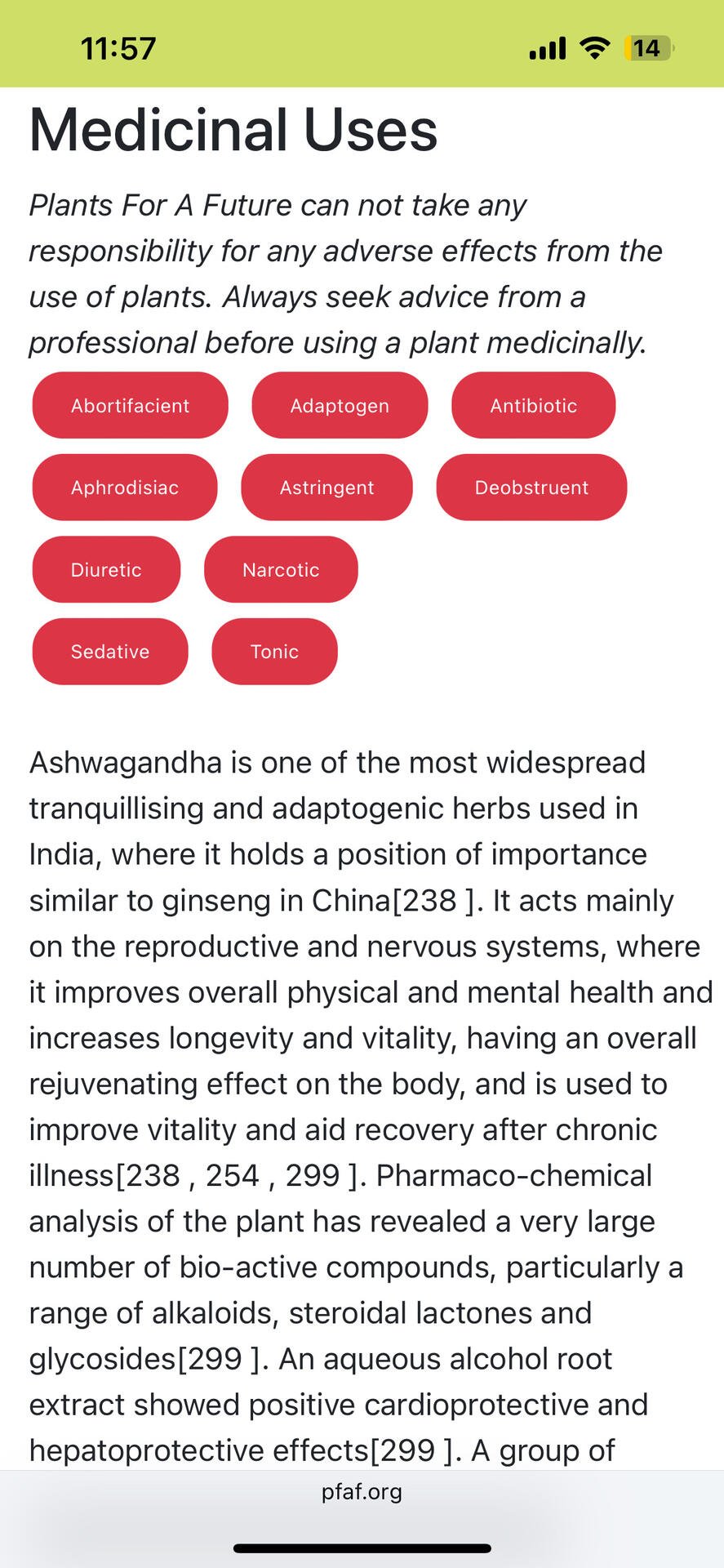Ashwagandha
Med Rating: 4/5
Description:
Ashwagandha is one of the most widespread tranquillising and adaptogenic herbs used in India, where it holds a position of importance similar to ginseng in China[238 ]. It acts mainly on the reproductive and nervous systems, where it improves overall physical and mental health and increases longevity and vitality, having an overall rejuvenating effect on the body, and is used to improve vitality and aid recovery after chronic illness[238 , 254 , 299 ]. Pharmaco-chemical analysis of the plant has revealed a very large number of bio-active compounds, particularly a range of alkaloids, steroidal lactones and glycosides[299 ]. An aqueous alcohol root extract showed positive cardioprotective and hepatoprotective effects[299 ]. A group of glycosides, known as sitoindosides, extracted from the roots showed significant antidepressant and anxiety-relieving properties. In a test for chronic stress, a root extract was compared with an extract from Panax ginseng; both extracts had a positive effect on several chronic stress symptoms, but the Withania somnifera extract did not cause the ginseng abuse syndrome, indicating a different mode of action[299 ]. Cognition enhancing tests of an aqueous ethanol extract containing the glycosides withaferin A and sitoindosides showed a positive effect on cholinergic signal transduction in the forebrain, which may partly explain its cognition-enhancing effect[299 ]. Tests have shown that ashwagandha can reverse memory deficits and also have a consolidating effect on the memory. Its effects upon the brain may provide leads towards treatments for Parkinson’s disease[299 ]. Aqueous alcohol extracts of the roots showed a positive effect on the cartilage of osteoarthritis patients both in vitro and in vivo[299 ]. The immunomodulatory effects of the withanolides (a group of steroidal lactones) have been studied extensively. Enhanced white blood cell counts and activity and inhibition of delayed-type hypersensitivity are among the processes reported[299 ]. Glyco-withanolides, including sitoindosides IX and X, have been shown to cause increased counts of platelets and red and white blood cells and increased activity of peritoneal macrophages and lysosomal enzymes[299 ]. The properties of the root extracts are very promising in cancer therapy; several studies indicate that they are correlated with the antioxidant effects. The extracts not only affect tumour growth but also have positive adjuvant effects in radiation and chemotherapy[299 ]. In an in-vitro experiment, the steroid lactone withaferin A inhibited growth in human cell lines of breast, central nervous system, colon and lung cancer[299 ]. A chloroform extract of the plant prevented cell proliferation by disrupting mitosis and inhibiting angiogenesis[299 ]. The addition of root powder to the diet has shown hypoglycaemic effects[299 ]. Although ashwagandha is used as an aphrodisiac, adding root powder to the diet has impaired the libido and sexual performance[299 ]. The methanolic extract of the roots has shown significant antibacterial activity against a range of bacteria[299 ]. When studying the anti-snake-venom properties of Withania somnifera, it was found that a glycoprotein isolated from an aqueous extract of the plant neutralized the toxic effects of phospholipase A2 from cobra venom. However, its mode of action may be too slow to provide a basis for pharmacological developments[299 ]. Side effects of the medicinal use of ashwagandha are rarely reported, but a case of thyrotoxicosis caused by its use was reported in the Netherlands. Symptoms disappeared when the treatment was stopped[299 ]. The whole plant, but especially the leaves and the root bark, are abortifacient, adaptogenic, antibiotic, aphrodisiac, deobstruent, diuretic, narcotic, strongly sedative and tonic[169 , 192 , 238 , 240 ]. Internally, it is used to tone the uterus after a miscarriage and also in treating post-partum difficulties[192 ]. It is also used to treat nervous exhaustion, debility, insomnia, wasting diseases, failure to thrive in children, impotence, infertility, multiple sclerosis etc[238 ]. Applied externally, the plant has been applied as a poultice to boils, wounds, swellings and other painful parts[192 , 240 , 775 ]. An ointment made from the leaves is applied to wounds and bed sores[299 ]. The root is harvested in the autumn and dried for later use[238 ]. Some caution is advised in the use of this plant since it is toxic[K ]. The fruit is diuretic[240 ]. The seed is diuretic and hypnotic[240 ].
Source: https://pfaf.org/user/Plant.aspx?LatinName=Withania+somnifera
#Health #ashwagandha #Plants #Herbs #HolisticHealing

